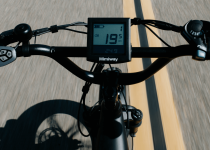How Do E-Bikes Work?
 Electric bikes are a relatively new invention that allows riders to go places they may not have been able to before. These powerful bikes work by sending energy to an electric motor through a battery pack which allows charging anywhere there is an electrical source.
Electric bikes are a relatively new invention that allows riders to go places they may not have been able to before. These powerful bikes work by sending energy to an electric motor through a battery pack which allows charging anywhere there is an electrical source.
These innovative e-bikes offer all the benefits of biking with fewer hassles than other modes of transportation, such as traffic or parking. Since, new, and veteran electric bike riders may be unfamiliar with how these bicycles work, let’s look at the different components that make these bikes tick.
Electric motors
There’s a lot of variation when it comes to electric bike motors. They can be anywhere from 250W up to 750W or even higher in some cases. There are also different types of electric motor setups that you might find on e-bikes. The most common on electric bikes is the geared rear hub motor because it’s an efficient way to get power from your battery pack into a rotating rear wheel.
The electric bike geared rear hub motor receives power from the battery through the throttle and converts the e-bike battery’s chemical energy into mechanical energy providing thrust to move the bike forward.
Direct drive motors are another option offered on e-bikes. They are more powerful and don’t have a built-in transmission, so they’re especially good for e-bike riders looking to tackle hills or long distances.
Front-wheel e-bike hub motors are also available. This is a good option for e-bike riders who want more responsiveness and maneuverability as it gives the sensation of an all-wheel-drive bicycle.
High-quality electric bike motors will have sealed cartridge ball bearings for reduced friction and a longer life span so that you can enjoy riding in comfort without worrying about the motor burning out.
Finally, electric bike motors come with an e-brake controlled by a brake lever or pedal and will stop the wheel from rotating when you’re slowing down.
E-bike batteries
There are many different battery types, and the electric bicycle that you choose will depend on your specific needs. Typically, a mid to high-range e-bike has either an 18650 lithium-ion or 26650 Li-ion battery. The lower-end e-bikes have traditional lead-acid batteries.
The components that make up an e-bike battery include:
- Anodes provide power to the electric bike. The anode contains lead dioxide and can vary
in size from a few millimeters wide to several centimeters in length. - Cathodes receive electricity during discharge. These contain nickel oxide or manganese
dioxide. - Electrodes are lead rods that connect to each of the battery plates.
- Electrolytes are a mixture of distilled water and sulfuric acid. It’s essential for e-bike
batteries because it helps the electrons flow freely between the anode and cathode during
discharge or charge cycles. - An insulator separates the battery plates from one another preventing short circuits from
occurring. - Lead wires carry power between the e-bike’s electrical system and its anodes or cathodes.
The electric bike battery provides power by converting chemical energy into electricity through a process called oxidation. It converts the electric bike power into energy that is safe for use in your bike’s electrical system, which then powers the electric motor.
Pedal assistance
The pedal-assist system on your e-bike provides power to help make pedaling easier and helps reduce fatigue during long rides. It does so by using sensors on the e-bike’s pedals. The pedal-assist system then increases the power of your e-bike motor as you pedal. This helps give you a boost when riding uphill or against headwinds.
The electric bike battery, electric motor, and pedal-assist system all work together to power your e-bike. Each component comes in many different types providing more or less power for various tasks and budgets.



